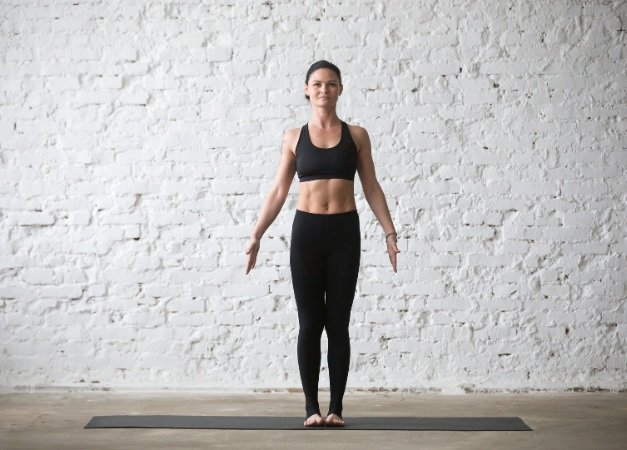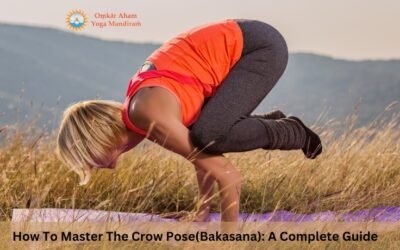Are you seeking a simple yet effective yoga pose to start your yoga journey? Look no further than Tadasana, also known as Mountain Pose. This standing pose is perfect for beginners, providing a solid foundation for other yoga poses and numerous benefits for your mind and body. In this article, we’ll explore Tadasana’s uses, steps, and precautions in detail.
What Is Tadasana?
Tadasana is a Sanskrit word that translates to “Mountain Pose” in English. It is a foundational yoga pose that involves standing tall with your feet hip-width apart and your arms by your sides. Tadasana is the starting position for many standing yoga poses and is also used as a warm-up exercise in many yoga classes.
Benefits Of Tadasana

Mountain Pose
Tadasana offers several benefits for both your mind and body. Some of the key benefits of Tadasana include:
1. Improves Posture
Tadasana helps improve your posture by aligning your body in a neutral position. This, in turn, reduces the risk of back and neck pain.
2. Increases Body Awareness
Tadasana increases your body awareness by making you mindful of your alignment, breathing, and overall body posture.
3. Improves Focus and Concentration
Tadasana requires you to maintain focus and concentration, which can help improve your overall mental clarity.
4. Strengthens the Legs and Feet
Tadasana strengthens the legs, feet, and ankles by engaging the muscles in these areas.
5. Relieves Stress and Anxiety
Tadasana helps calm the mind and reduce stress and anxiety by promoting relaxation and deep breathing.
How To Do Tadasana?
Before attempting Tadasana, it’s essential to warm up your body with some preparatory poses. Then, once you’re ready, follow these step-by-step instructions:
Preparatory Poses
Warm-up exercises such as Surya Namaskar (Sun Salutation) or Ardha Chakrasana (Half Moon Pose) can help prepare your body for Tadasana.
Step-By-Step Instructions
- Stand with your feet hip-width apart and your arms by your flanks.
- Press your feet firmly into the ground, engaging your leg muscles.
- Lift your kneecaps by contracting your thigh muscles.
- Engage your lower abdominal muscles by pulling your navel inwards towards your spine.
- Lengthen your spine and lift the crown of your head towards the ceiling.
- Relax your shoulders and extend your arms down by your sides.
- Maintain the pose for 30-60 seconds, breathing deeply.
Common Mistakes To Avoid
- Avoid locking your knees or hyperextending your joints.
- Keep your weight evenly spread between both feet.
- Don’t slouch your shoulders or tilt your head forward.
Performing Mountain Pose
Precautions And Contraindication
While Tadasana is generally safe for most people, it’s important to keep the following precautions and contraindications in mind:
- Avoid Tadasana if you have low blood pressure or vertigo.
- If you have a history of back or spinal injuries, speak to your doctor or a certified yoga instructor before attempting Tadasana.
- Pregnant women should avoid Tadasana in the later stages of pregnancy.
Variations of Tadasana
Tadasana can be modified or varied to suit your needs and skill level. Some common variations of Tadasana include:
- Ardha Tadasana (Half Mountain Pose)
- Urdhva Hastasana (Upward Salute)
- Parvatasana (Mountain Pose with Raised Arms)
How To Incorporate Tadasana Into Your Yoga Practice
Tadasana can be practised on its own or as part of a sequence. Here are some common ways to incorporate Tadasana into your yoga practice:
- As a warm-up exercise
- As a preparatory pose for other standing poses
- As a starting position for meditation
- As a resting pose between other standing poses
Tadasana Vs. Samasthiti: What’s The Difference?
Tadasana and Samasthiti are standing yoga poses that involve standing tall with your feet hip-width apart and your arms by your sides. The main difference between the two poses is that Tadasana is a foundational pose often used as a starting position for other standing poses, while Samasthiti is more of a transition pose used to reset the body between different poses.
Tadasana And Meditation
Tadasana can be used as a starting position for meditation due to its grounding and centring nature. Practising Tadasana before meditation can help calm the mind and prepare the body for stillness.
Tadasana And Breathing
To enhance its benefits, Tadasana can be combined with different breathing techniques, such as deep belly or ujjayi breathing. Focusing on the breath in Tadasana can also help stimulate relaxation and reduce stress and anxiety.
Tadasana And Chakras
Tadasana is said to activate the root chakra, also known as the Muladhara chakra, located at the base of the spine. This chakra is associated with feelings of grounding and stability.
Tadasana And Alignment
Tadasana is all about alignment. By practising Tadasana regularly, you can train your body to maintain proper alignment, improving your posture and reducing the risk of injury.
Tadasana And Body Awareness
Tadasana can help increase your body awareness by making you more mindful of your alignment, breathing, and overall body posture. This increased awareness can carry over into other areas of your life, such as your sitting or standing posture.
Tadasana And Posture
Tadasana is one of the best yoga poses for improving posture. By practising Tadasana regularly, you can train your body to maintain proper alignment, which can reduce the risk of back and neck pain.
Conclusion
Tadasana is a simple yet effective yoga pose that offers numerous mental and physical benefits. Practising Tadasana regularly can improve your posture, increase your body awareness, and reduce stress and anxiety. Remember to follow the steps and precautions outlined in this article, and consult a certified yoga instructor if you have any concerns or questions.
You can also join the 200-hour yoga teacher training Rishikesh in Omkar Aham Yoga Mandiram.
For further details, contact us at:
Call/WhatsApp: +91-9997744876
Mail us at: info@yogateachertrainingschool.com




